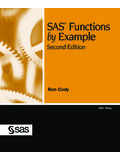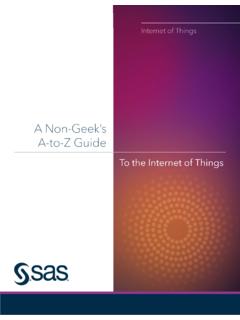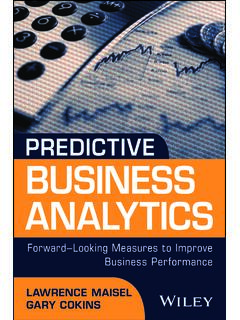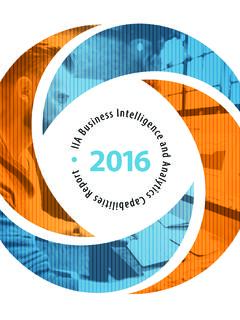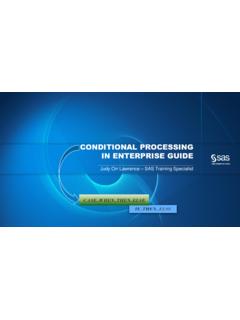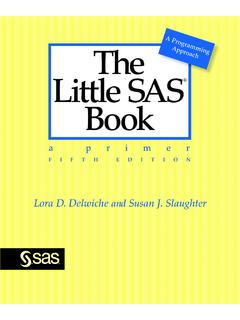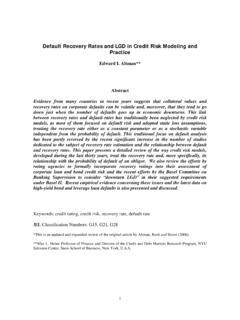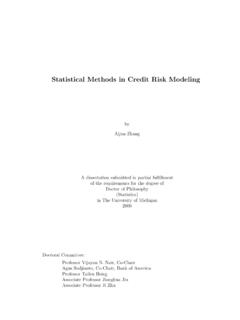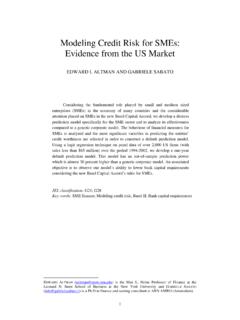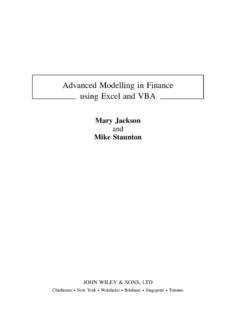Transcription of Developing Credit Risk Models Using SAS® …
1 Iain L. J. Brown, PhDDeveloping Credit Risk Models Using SAS Enterprise Miner a nd SAS/STAT Theory and ApplicationsContents About this Book .. ix About the Author .. xiii Acknowledgments ..xv Chapter 1 Introduction .. 1 Book 1 Overview of Credit Risk modeling .. 2 Regulatory Environment .. 3 Minimum Capital Requirements .. 4 Expected 5 Unexpected Loss .. 6 Risk Weighted Assets .. 6 SAS Software Utilized .. 7 Chapter Summary .. 11 References and Further Reading .. 11 Chapter 2 Sampling and Data Pre-Processing .. 13 Introduction .. 13 Sampling and Variable Selection .. 16 Sampling .. 17 Variable Selection .. 18 Missing Values and Outlier Treatment .. 19 Missing Values .. 19 Outlier Detection.
2 21 Data Segmentation .. 22 Decision Trees for Segmentation .. 23 K-Means Clustering .. 24 From Developing Credit Risk Models Using SAS Enterprise Miner and SAS/STAT . Full book available for purchase Contents Chapter Summary .. 25 References and Further Reading .. 25 Chapter 3 Development of a Probability of Default (PD) model .. 27 Overview of Probability of Default .. 27 PD Models for Retail Credit .. 28 PD Models for Corporate Credit .. 28 PD Calibration .. 29 Classification Techniques for PD .. 29 Logistic Regression .. 29 Linear and Quadratic Discriminant Analysis .. 31 Neural Networks .. 32 Decision Trees .. 33 Memory Based Reasoning .. 34 Random Forests .. 34 Gradient Boosting.
3 35 model Development (Application Scorecards) .. 35 Motivation for Application 36 Developing a PD model for Application Scoring .. 36 model Development (Behavioral Scoring) .. 47 Motivation for Behavioral Scorecards .. 48 Developing a PD model for Behavioral Scoring .. 49 PD model Reporting .. 52 Overview .. 52 Variable Worth Statistics .. 52 Scorecard Strength .. 54 model Performance Measures .. 54 Tuning the model .. 54 model Deployment .. 55 Creating a model Package .. 55 Registering a model Package .. 56 Chapter Summary .. 57 References and Further Reading .. 58 Contents v Chapter 4 Development of a Loss Given Default (LGD) model .. 59 Overview of Loss Given Default .. 59 LGD Models for Retail Credit .
4 60 LGD Models for Corporate Credit .. 60 Economic Variables for LGD Estimation .. 61 Estimating Downturn LGD .. 61 Regression Techniques for LGD .. 62 Ordinary Least Squares Linear Regression .. 64 Ordinary Least Squares with Beta Transformation .. 64 Beta Regression .. 65 Ordinary Least Squares with Box-Cox Transformation .. 66 Regression Trees .. 67 Artificial Neural Networks .. 67 Linear Regression and Non-linear Regression .. 68 Logistic Regression and Non-linear 68 Performance Metrics for LGD .. 69 Root Mean Squared Error .. 69 Mean Absolute Error .. 70 Area Under the Receiver Operating Curve .. 70 Area Over the Regression Error Characteristic Curves .. 71 R-square .. 72 Pearson s Correlation 72 Spearman s Correlation Coefficient.
5 72 Kendall s Correlation Coefficient .. 73 model Development .. 73 Motivation for LGD Models .. 73 Developing an LGD model .. 73 Case Study: Benchmarking Regression Algorithms for LGD .. 77 Data Set Characteristics .. 77 Experimental Set-Up .. 78 Results and Discussion .. 79 Chapter Summary .. 83 References and Further Reading .. 84 vi Contents Chapter 5 Development of an Exposure at Default (EAD) model .. 87 Overview of Exposure at Default .. 87 Time Horizons for CCF .. 88 Data Preparation .. 90 CCF Distribution Transformations .. 95 model Development .. 97 Input Selection .. 97 model Methodology .. 97 Performance Metrics .. 99 model Validation and Reporting .. 103 model Validation.
6 103 Reports .. 104 Chapter Summary .. 106 References and Further Reading .. 107 Chapter 6 Stress Testing .. 109 Overview of Stress Testing .. 109 Purpose of Stress Testing .. 110 Stress Testing Methods .. 111 Sensitivity Testing .. 111 Scenario Testing .. 112 Regulatory Stress Testing .. 113 Chapter Summary .. 114 References and Further Reading .. 114 Chapter 7 Producing model Reports .. 115 Surfacing Regulatory Reports .. 115 model Validation .. 115 model Performance .. 116 model Stability .. 122 model Calibration .. 125 SAS model Manager 127 Create a PD Report .. 127 Create a LGD Report .. 129 Chapter Summary .. 130 Contents vii Tutorial A Getting Started with SAS Enterprise Miner.
7 131 S tarting SAS Enterprise Miner .. 131 Assigning a Library Location .. 134 Defining a New Data Set .. 136 Tutorial B Developing an Application Scorecard model in SAS Enterprise Miner .. 139 Overview .. 139 Step 1 Import the XML Diagram .. 140 Step 2 Define the Data Source .. 140 Step 3 Visualize the Data .. 141 Step 4 Partition the Data .. 143 Step 5 Perform Screening and Grouping with Interactive Grouping .. 143 Step 6 Create a Scorecard and Fit a Logistic Regression model .. 144 Step 7 Create a Rejected Data Source .. 144 Step 8 Perform Reject Inference and Create an Augmented Data Set .. 144 Step 9 Partition the Augmented Data Set into Training, Test and Validation Samples.
8 145 Step 10 Perform Univariate Characteristic Screening and Grouping on the Augmented Data Set .. 145 Step 11 Fit a Logistic Regression model and Score the Augmented Data Set .. 145 Tutorial Summary .. 146 Appendix A Data Used in This Book .. 147 Data Used in This Book .. 147 Chapter 3: Known Good Bad Data .. 147 Chapter 3: Rejected Candidates Data .. 148 Chapter 4: LGD Data .. 148 Chapter 5: Exposure at Default Data .. 149 Index .. 151 From Developing Credit Risk Models Using SAS Enterprise Miner and SAS/STAT : Theory and Application, by Iain Brown. Copyright 2014, SAS Institute Inc., Cary, North Carolina, USA. ALL RIGHTS 1 Introduction Book Overview .. 1 Overview of Credit Risk modeling .. 2 Regulatory Environment.
9 3 Minimum Capital Requirements .. 4 Expected Loss .. 5 Unexpected Loss .. 6 Risk Weighted Assets .. 6 SAS Software Utilized .. 7 Chapter Summary ..11 References and Further Reading ..11 Book Overview This book aims to define the concepts underpinning Credit risk modeling and to show how these concepts can be formulated with practical examples Using SAS software. Each chapter tackles a different problem encountered by practitioners working or looking to work in the field of Credit risk and give a step-by-step approach to leverage the power of the SAS Analytics suite of software to solve these issues. This chapter begins by giving an overview of what Credit risk modeling entails, explaining the concepts and terms that one would typically come across working in this area.
10 We then go on to scrutinize the current regulatory environment, highlighting the key reporting parameters that need to be estimated by financial institutions subject to the Basel capital requirements. Finally, we discuss the SAS analytics software used for the analysis part of this book. From Developing Credit Risk Models Using SAS Enterprise Miner and SAS/STAT . Full book available for purchase Developing Credit Risk Models Using SAS Enterprise Miner and SAS/STAT The remaining chapters are structured as follows: Chapter 2 covers the area of sampling and data pre-processing. This chapter defines and contextualizes issues such as variable selection, missing values, and outlier detection within the area of Credit risk modeling , and gives practical applications of how these issues can be solved.

